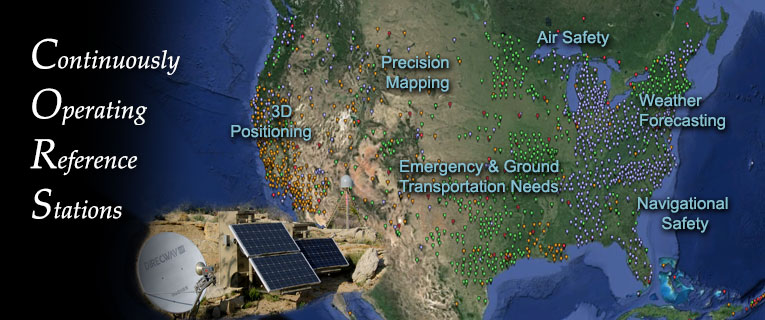Archive of NOAA Continuously Operating Reference Stations (CORS) Network (NCN)
The National Geodetic Survey's (NGS) NOAA Continuously Operating Reference Stations
(CORS) Network (NCN) provides Global Navigation Satellite System (GNSS) data consisting
of carrier phase and code range measurements in support of three dimensional positioning,
meteorology, space weather, and geophysical applications throughout the United States,
its territories, and a few foreign countries. Surveyors, GIS users, engineers, scientists,
and the public at large that collect GPS data can use CORS data to improve the precision
of their positions. CORS enhanced post-processed coordinates approach a few centimeters
relative to the National Spatial Reference System (NSRS), both horizontally and vertically.
The CORS network is a multi-purpose cooperative endeavor involving government, academic,
and private organizations. The sites are independently owned and operated. Each agency
shares their data with NGS, and NGS in turn analyzes and distributes the data free
of charge.
- Cite as: NOAA National Geodetic Survey (NGS). 1994. NOAA Archive of NGS National Continuously Operating Reference Station (CORS) Network (NCN) [indicate subset used]. NOAA National Centers for Environmental Information. https://doi.org/10.25921/wc4r-ee36. Accessed [date].
- 10.25921/wc4r-ee36
- NCEI Metadata ID: gov.noaa.ngdc.stp.terrestrial:G10019
gov.noaa.ngdc.stp.terrestrial:G10019
| Order Data |
|
| Distribution Formats |
|
| Ordering Instructions | Contact NCEI for other distribution options and instructions. |
| Distributor | NOAA National Centers for Environmental Information ncei.info@noaa.gov |
| Dataset Point of Contact | NOAA National Centers for Environmental Information ncei.info@noaa.gov |
| Dataset Point of Contact | Francine Coloma (303) 497-3692 ngs.cors@noaa.gov |
| Coverage Description | CORS data is collected throughout the United States, its territories, and a few foreign countries. |
| Time Period | 1994-02-01 to Present |
| Spatial Bounding Box Coordinates |
West:-180.00
East:180.00
South:-90.00
North:90.00
|
| Spatial Coverage Map | |
| General Documentation | |
| Associated Resources |
|
| Publication Dates |
|
| Dataset Progress Status | ongoing |
| Data Update Frequency | Daily |
| Supplemental Information |
The United States operates the Global Positioning System (GPS). The term Global Navigation
Satellite Systems (GNSS) has been created to reference all navigation satellite systems.
GNSS encompasses the U.S. GPS system, the Russian Federation GLONASS system, and any
future systems such as Europe's Galileo or China's Compass.
|
| Purpose | The CORS data set enables users to attain centimeter-level positioning for points of interest and can be used to measure crustal motion, moisture content for the lower atmosphere, and total electronic content in the upper atmosphere. NGS publishes coordinates for CORS in several reference frames. This includes the current global reference frame from the International GNSS Service (IGS), and with respect to the National Spatial Reference System (NSRS) realizations of the North American Datum of 1983 (NAD 83) as defined by NGS. |
| Use Limitations |
|
| Dataset Citation |
|
| Cited Authors |
|
| Publishers |
|
| Acknowledgments |
|
| Theme keywords | Global Change Master Directory (GCMD) Science Keywords
|
| Data Center keywords | Global Change Master Directory (GCMD) Data Center Keywords
|
| Platform keywords | Global Change Master Directory (GCMD) Platform Keywords
|
| Instrument keywords | Global Change Master Directory (GCMD) Instrument Keywords
|
| Place keywords | Getty Thesaurus of Geographic Names
|
| Project keywords | Global Change Master Directory (GCMD) Project Keywords
|
| Use Constraints |
|
| Access Constraints |
|
| Other Constraints | Cite as: NOAA National Geodetic Survey (NGS). 1994. NOAA Archive of NGS National Continuously Operating Reference Station (CORS) Network (NCN) [indicate subset used]. NOAA National Centers for Environmental Information. https://doi.org/10.25921/wc4r-ee36. Accessed [date]. |
| Fees |
|
| Lineage Statement | GNSS observational data from the CORS network are ingested, translated, and processed by NGS and are posted to the NGS online servers as hourly or daily files, and ultimately retained as daily files in RINEX format. After 30 days, data in the at-sampling rate is copied to the NCEI archive, and NGS online holdings are then decimated to a 30-second sampling rate. Special use case: Certain groups such as the Federal Aviation Administration, make GNSS data available in binary format to NGS. These data are used as input to algorithms for internal NOAA models such as the US-Total Electron Content product. The Data Center, not NGS, has decided to archive the raw data from these stations as a daily tar file consisting of hourly binary files |
| Processor |
|
| Processing Steps |
|
| Source Datasets |
| Processing Steps |
|
| Instrument |
|
| Platform |
|
Last Modified: 2023-09-14
For questions about the information on this page, please email:ncei.info@noaa.gov
